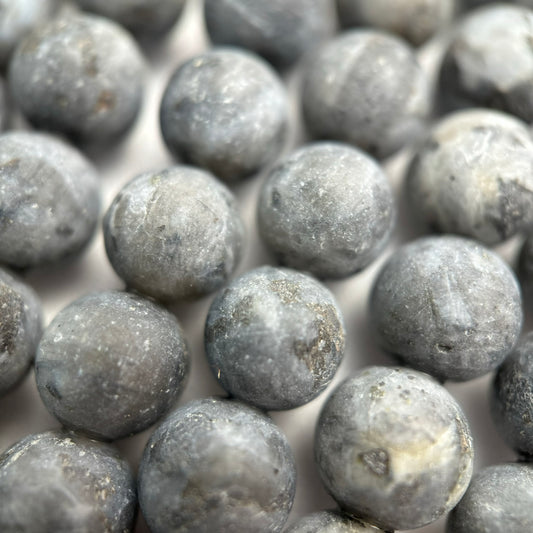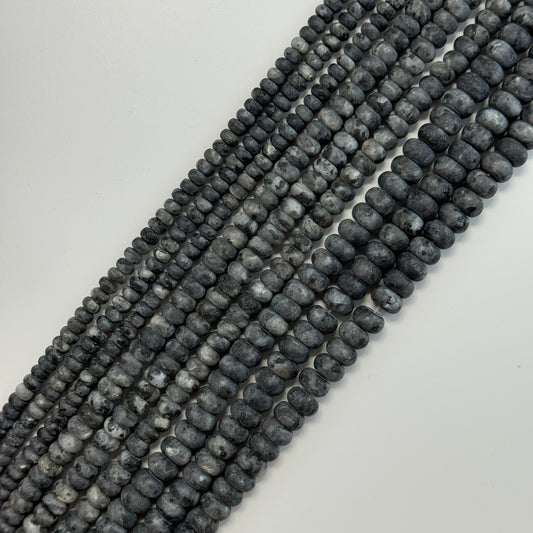Discovering Larvikite Gemstone Beads
Larvikite is a distinctive feldspar-rich igneous rock known for its iridescent blue-gray appearance and labradorescence. This Norwegian gemstone displays a unique shimmering effect that makes it highly sought after for jewelry and decorative purposes.
Distinctive Characteristics
- Iridescent blue-gray labradorescence
- Feldspar-rich composition
- Metallic-like shimmer effect
- Mohs hardness of 6-6.5
- Distinctive Norwegian origin
Mineralogical Composition
Larvikite consists primarily of feldspar minerals, particularly anorthoclase and oligoclase, with smaller amounts of pyroxene, amphibole, and other accessory minerals.
Composition Details
- Primary: Feldspar group minerals
- Anorthoclase: Sodium-potassium feldspar
- Oligoclase: Plagioclase feldspar
- Accessory: Pyroxene, amphibole
- Crystal system: Monoclinic/Triclinic
Labradorescence and Optical Effects
The most striking feature of Larvikite is its labradorescence, a play of colors caused by light interference within the feldspar crystals. This creates a shimmering, metallic-like appearance.
Optical Properties
- Labradorescence: Blue-gray shimmer
- Light interference in feldspar layers
- Metallic-like appearance
- Color play varies with viewing angle
- Polished surfaces enhance effect
Geological Formation and Origin
Larvikite forms from the slow cooling of magma deep within the Earth's crust. It's named after Larvik, Norway, where it was first identified and is primarily sourced.
Formation Process
- Intrusive igneous rock formation
- Slow cooling of feldspar-rich magma
- Crystal growth over extended periods
- Specific geological conditions required
- Limited geographic distribution
Color Variations and Patterns
Larvikite displays various shades of blue-gray with the characteristic labradorescent shimmer. The intensity and color of the effect can vary between specimens.
Color Characteristics
- Base color: Dark blue-gray to black
- Labradorescence: Blue, silver, gray
- Pattern variations in each piece
- Some specimens show green tones
- Polished surfaces reveal full effect
Cutting and Polishing Techniques
Proper cutting and polishing are essential to maximize Larvikite's labradorescence. The stone takes an excellent polish that enhances its shimmering effect.
Lapidary Methods
- Cabochon cutting for smooth surfaces
- High polish essential for labradorescence
- Various shapes: round, oval, freeform
- Bead drilling requires care
- Surface orientation affects appearance
Hardness and Durability
With a Mohs hardness of 6-6.5, Larvikite offers moderate durability for jewelry use. Proper care helps maintain its polished appearance.
Durability Factors
- Mohs hardness: 6-6.5
- Good polish retention
- Moderate resistance to scratching
- Stable under normal conditions
- Suitable for jewelry with care
Geographic Sources
Larvikite is primarily sourced from Norway, specifically the Larvik area. It's also found in smaller quantities in other locations worldwide.
Primary Sources
- Norway: Larvik region (primary source)
- Limited deposits elsewhere
- Commercial availability from Norway
- Quality varies by location
- Norwegian material most prized
Care and Maintenance
Larvikite requires standard care to maintain its polished surface and labradorescent effect. Proper cleaning preserves its appearance.
Care Guidelines
- Clean with warm soapy water
- Soft cloth for drying and polishing
- Avoid harsh chemicals
- Store separately to prevent scratching
- Occasional repolishing restores shine
Jewelry Design Applications
Larvikite beads create distinctive jewelry pieces with their unique shimmering effect. The stone works well in both contemporary and traditional designs.
Design Uses
- Strand necklaces showcasing labradorescence
- Bracelets with polished beads
- Earrings highlighting shimmer
- Combinations with complementary stones
- Modern and classic styles
Cultural and Historical Significance
Larvikite holds cultural significance in Norway and is valued for its unique appearance. It's often used in architectural applications as well as jewelry.
Cultural Aspects
- Norwegian national stone
- Used in architecture and monuments
- Valued for unique appearance
- Symbolic of Norwegian geology
- Appreciated worldwide
Comparison with Similar Materials
Larvikite may be confused with other feldspar-rich rocks or labradorite. Understanding its specific characteristics aids in identification.
Distinguishing Features
- Specific Norwegian origin
- Distinctive blue-gray labradorescence
- Feldspar-rich composition
- Different from labradorite in appearance
- Unique geological formation
Frequently Asked Questions
What is the mineralogical composition and rock type classification of Larvikite?
Larvikite is a variety of monzonite, which is an igneous intrusive rock composed primarily of feldspar (both plagioclase and alkali feldspar), with smaller amounts of pyroxene, biotite, and other minerals. It's classified as a monzonitic syenite, named after the Larvik region in Norway where it was first identified.
What causes the distinctive labradorescence (schiller effect) in Larvikite beads?
The labradorescence in Larvikite is caused by light interference from lamellar intergrowths of different feldspar phases within the crystals. These thin, alternating layers of different feldspar compositions create iridescent blue, silver, and sometimes green flashes when light strikes the surface at specific angles.
What is the Mohs hardness and how does it vary in Larvikite?
Larvikite has a Mohs hardness ranging from 6 to 6.5, which comes from its feldspar content (feldspars typically have hardness 6-6.5). This makes it moderately hard and suitable for jewelry, though it's softer than quartz-based gemstones. The hardness is relatively uniform throughout the material.
What are the primary mineral components that make up Larvikite?
Larvikite consists primarily of feldspar minerals (approximately 60-70%), including both plagioclase feldspar and alkali feldspar (orthoclase or microcline). It also contains pyroxene (augite), biotite mica, and sometimes small amounts of quartz, apatite, or other accessory minerals.
What is the geological origin and formation process of Larvikite?
Larvikite forms as an intrusive igneous rock, meaning it crystallized slowly beneath the Earth's surface from magma. It's part of the Permian-age Oslo Rift system in Norway, formed approximately 280-250 million years ago. The slow cooling allowed large feldspar crystals to develop with the characteristic lamellar structures.
What are the primary sources of Larvikite gemstone material?
Larvikite is primarily sourced from the Larvik region in Vestfold County, Norway, where it's quarried extensively. Some material also comes from other locations in the Oslo region. Norwegian Larvikite is considered the finest quality, though similar monzonitic rocks with labradorescence are found in other locations worldwide.
How does the specific gravity of Larvikite compare to other gemstone materials?
Larvikite has a specific gravity ranging from 2.7 to 2.9, which is similar to many feldspar-based gemstones. This density is higher than quartz (2.65) but lower than many heavier gemstones. The specific gravity can vary slightly depending on the exact mineral composition and presence of inclusions.
What is the difference between Larvikite and Labradorite in terms of mineralogy?
While both exhibit labradorescence, Larvikite is a rock (monzonite) composed of multiple minerals, while Labradorite is a single feldspar mineral (plagioclase). Larvikite's labradorescence comes from feldspar intergrowths within a rock matrix, while Labradorite's effect comes from internal structures within a single mineral species.
How does the crystal size and texture affect Larvikite bead appearance?
Larvikite typically has a medium to coarse-grained texture with feldspar crystals visible to the naked eye. The size and orientation of these crystals affect how the labradorescence appears in beads. Larger crystals with well-developed lamellar structures produce more dramatic iridescent effects.
What cutting and polishing techniques maximize Larvikite's labradorescence?
Cutters must orient Larvikite to maximize the display of labradorescent flashes, typically cutting perpendicular to the lamellar structures. Polishing is crucial to reveal the full iridescent effect, requiring careful attention to surface finish. The angle of cut relative to the feldspar crystal orientation significantly impacts the visual result.
Can Larvikite be enhanced or treated to improve its appearance?
Larvikite is typically not treated, as the labradorescence is a natural property of its mineral structure. However, proper cutting and polishing are essential to maximize the effect. Some lower-quality material may be dyed, but natural, untreated Larvikite with strong labradorescence is most valued.
What causes the color variations in Larvikite's labradorescent flashes?
The color of labradorescent flashes depends on the thickness and composition of the lamellar intergrowths within the feldspar crystals. Thinner layers produce blue flashes, while thicker layers can create green, gold, or red flashes. The specific feldspar compositions also influence the colors observed.
How should Larvikite beads be cleaned and maintained?
Clean Larvikite beads with warm, soapy water and a soft cloth. Avoid harsh chemicals, ultrasonic cleaners, or steam cleaning that could damage the polished surface or affect the feldspar minerals. Store separately from harder materials to prevent scratching, and avoid exposure to acids.
What makes Larvikite beads unique compared to other iridescent gemstones?
Larvikite is unique because it's one of the few rock types (rather than single minerals) used as a gemstone material. Its labradorescence comes from the complex intergrowth of feldspar phases within an igneous rock matrix, creating a distinctive appearance that combines the beauty of iridescence with the character of natural stone texture.
How does the age and geological history of Larvikite affect its quality?
The Permian age (280-250 million years) and slow cooling history of Larvikite allowed for the development of large, well-formed feldspar crystals with optimal lamellar structures. This geological history is crucial for the quality of labradorescence, as rapid cooling would not have allowed the necessary crystal growth and intergrowth formation.





